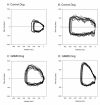Respiratory dysfunction in unsedated dogs with golden retriever muscular dystrophy
- PMID: 24295812
- PMCID: PMC3911885
- DOI: 10.1016/j.nmd.2013.10.001
Respiratory dysfunction in unsedated dogs with golden retriever muscular dystrophy
Abstract
Golden retriever muscular dystrophy (GRMD) is a well-established model of Duchenne muscular dystrophy. The value of this model would be greatly enhanced with practical tools to monitor progression of respiratory dysfunction during treatment trials. Arterial blood gas analysis, tidal breathing spirometry, and respiratory inductance plethysmography (RIP) were performed to determine if quantifiable abnormalities could be identified in unsedated, untrained, GRMD dogs. Results from 11 dogs with a mild phenotype of GRMD and 11 age-matched carriers were compared. Arterial blood gas analysis was successfully performed in all dogs, spirometry in 21 of 22 (95%) dogs, and RIP in 18 of 20 (90%) dogs. Partial pressure of carbon dioxide and bicarbonate concentration were higher in GRMD dogs. Tidal breathing peak expiratory flows were markedly higher in GRMD dogs. Abnormal abdominal motion was present in 7 of 10 (70%) GRMD dogs. Each technique provided objective, quantifiable measures that will be useful for monitoring respiratory function in GRMD dogs during clinical trials while avoiding the influence of sedation on results. Increased expiratory flows and the pattern of abdominal breathing are novel findings, not reported in people with Duchenne muscular dystrophy, and might be a consequence of hyperinflation.
Keywords: Blood gas analysis; Flow-volume loop; Golden retriever muscular dystrophy; Muscular dystrophy; Pulmonary function test; Respiratory inductance plethysmography; Spirometry.
Copyright © 2013 Elsevier B.V. All rights reserved.
Figures


Similar articles
-
Expiratory dysfunction in young dogs with golden retriever muscular dystrophy.Neuromuscul Disord. 2020 Nov;30(11):930-937. doi: 10.1016/j.nmd.2020.09.027. Epub 2020 Sep 20. Neuromuscul Disord. 2020. PMID: 33071066 Free PMC article.
-
Gait characterization in golden retriever muscular dystrophy dogs using linear discriminant analysis.BMC Musculoskelet Disord. 2017 Apr 12;18(1):153. doi: 10.1186/s12891-017-1494-4. BMC Musculoskelet Disord. 2017. PMID: 28403854 Free PMC article.
-
Natural History of Cardiomyopathy in Adult Dogs With Golden Retriever Muscular Dystrophy.J Am Heart Assoc. 2019 Aug 20;8(16):e012443. doi: 10.1161/JAHA.119.012443. Epub 2019 Aug 14. J Am Heart Assoc. 2019. PMID: 31411085 Free PMC article.
-
Impaired autophagy correlates with golden retriever muscular dystrophy phenotype.Muscle Nerve. 2018 Sep;58(3):418-426. doi: 10.1002/mus.26121. Epub 2018 Apr 1. Muscle Nerve. 2018. PMID: 29513363
-
Canine models of Duchenne muscular dystrophy and their use in therapeutic strategies.Mamm Genome. 2012 Feb;23(1-2):85-108. doi: 10.1007/s00335-011-9382-y. Epub 2012 Jan 5. Mamm Genome. 2012. PMID: 22218699 Free PMC article. Review.
Cited by
-
Expiratory dysfunction in young dogs with golden retriever muscular dystrophy.Neuromuscul Disord. 2020 Nov;30(11):930-937. doi: 10.1016/j.nmd.2020.09.027. Epub 2020 Sep 20. Neuromuscul Disord. 2020. PMID: 33071066 Free PMC article.
-
Breathing in Duchenne muscular dystrophy: translation to therapy.J Physiol. 2022 Aug;600(15):3465-3482. doi: 10.1113/JP281671. Epub 2022 Jun 24. J Physiol. 2022. PMID: 35620971 Free PMC article. Review.
-
Pharmacologic management of Duchenne muscular dystrophy: target identification and preclinical trials.ILAR J. 2014;55(1):119-49. doi: 10.1093/ilar/ilu011. ILAR J. 2014. PMID: 24936034 Free PMC article. Review.
-
Laminin-111 protein therapy enhances muscle regeneration and repair in the GRMD dog model of Duchenne muscular dystrophy.Hum Mol Genet. 2019 Aug 15;28(16):2686-2695. doi: 10.1093/hmg/ddz086. Hum Mol Genet. 2019. PMID: 31179490 Free PMC article.
-
Quantifiable features of a tidal breathing phenotype in dogs with severe bronchomalacia diagnosed by bronchoscopy.Vet Q. 2023 Dec;43(1):1-10. doi: 10.1080/01652176.2023.2252518. Vet Q. 2023. PMID: 37616027 Free PMC article.
References
-
- Emery AE. Population frequencies of inherited neuromuscular diseases--a world survey. Neuromuscul Disord. 1991;1:19–29. - PubMed
-
- Inkley SR, Oldenburg FC, Vignos PJ., Jr Pulmonary function in Duchenne muscular dystrophy related to stage of disease. Am J Med. 1974;56:297–306. - PubMed
-
- Laghi F, Tobin MJ. Disorders of the respiratory muscles. Am J Respir Crit Care Med. 2003;168:10–48. - PubMed
-
- Gozal D. Pulmonary manifestations of neuromuscular disease with special reference to Duchenne muscular dystrophy and spinal muscular atrophy. Pediatr Pulmonol. 2000;29:141–150. - PubMed
Publication types
MeSH terms
Grants and funding
LinkOut - more resources
Full Text Sources
Other Literature Sources
Miscellaneous

